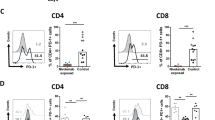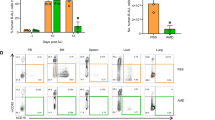Abstract
Graft-versus-host disease (GVHD) is the main complication after allogeneic hematopoietic stem cell transplantation. We previously unveiled a correlation between proportions of C-C motif chemokine receptor 7 (CCR7)+ T cells in the apheresis and the risk of developing GVHD. We wanted to evaluate in vivo whether apheresis with low proportion of CCR7+ cells or treatment with an anti-human CCR7 monoclonal antibody (mAb) were suitable strategies to prevent or treat acute GVHD in preclinical xenogeneic models. Therapeutic anti-CCR7 mAb was the most effective strategy in both prophylactic and therapeutic settings where antibody drastically reduced in vivo lymphoid organ infiltration of donor CCR7+ T cells, extended lifespan and solved clinical signs. The antibody neutralized in vitro migration of naïve and central memory T cells toward CCR7 ligands and depleted target CCR7+ subsets through complement activation. Both mechanisms of action spared CCR7− subsets, including effector memory and effector memory CD45RA+ T cells which may mediate graft versus leukemia effect and immunity against infections. Accordingly, the numbers of donor CCR7+ T cells in the apheresis were not associated to cytomegalovirus reactivation or the recurrence of the underlying disease. These findings provide a promising new strategy to prevent and treat acute GVHD, a condition where new specific, safety and effective treatment is needed.
This is a preview of subscription content, access via your institution
Access options
Subscribe to this journal
Receive 12 print issues and online access
$259.00 per year
only $21.58 per issue
Buy this article
- Purchase on Springer Link
- Instant access to full article PDF
Prices may be subject to local taxes which are calculated during checkout




Similar content being viewed by others
References
Shlomchik WD. Graft-versus-host disease. Nat Rev Immunol. 2007;7:340–52.
Toubai T, Sun Y, Reddy P. GVHD pathophysiology: is acute different from chronic? Best Pr Res Clin Haematol. 2008;21:101–17.
Wysocki CA, Panoskaltsis-Mortari A, Blazar BR, Serody JS. Leukocyte migration and graft-versus-host disease. Blood. 2005;105:4191–9.
Shlomchik WD, Couzens MS, Tang CB, McNiff J, Robert ME, Liu J, et al. Prevention of graft versus host disease by inactivation of host antigen-presenting cells. Science. 1999;285:412–5.
Beilhack A, Schulz S, Baker J, Beilhack GF, Nishimura R, Baker EM, et al. Prevention of acute graft-versus-host disease by blocking T-cell entry to secondary lymphoid organs. Blood. 2008;111:2919–28.
Forster R, Schubel A, Breitfeld D, Kremmer E, Renner-Muller I, Wolf E, et al. CCR7 coordinates the primary immune response by establishing functional microenvironments in secondary lymphoid organs. Cell. 1999;99:23–33.
von Andrian UH, Mempel TR. Homing and cellular traffic in lymph nodes. Nat Rev Immunol. 2003;3:867–78.
Moschovakis GL, Forster R. Multifaceted activities of CCR7 regulate T-cell homeostasis in health and disease. Eur J Immunol. 2012;42:1949–55.
Sallusto F, Lenig D, Forster R, Lipp M, Lanzavecchia A. Two subsets of memory T lymphocytes with distinct homing potentials and effector functions. Nature. 1999;401:708–12.
Foster AE, Marangolo M, Sartor MM, Alexander SI, Hu M, Bradstock KF, et al. Human CD62L- memory T cells are less responsive to alloantigen stimulation than CD62L+ naive T cells: potential for adoptive immunotherapy and allodepletion. Blood. 2004;104:2403–9.
Macedo C, Orkis EA, Popescu I, Elinoff BD, Zeevi A, Shapiro R, et al. Contribution of naive and memory T-cell populations to the human alloimmune response. Am J Transpl. 2009;9:2057–66.
Distler E, Bloetz A, Albrecht J, Asdufan S, Hohberger A, Frey M, et al. Alloreactive and leukemia-reactive T cells are preferentially derived from naive precursors in healthy donors: implications for immunotherapy with memory T cells. Haematologica. 2011;96:1024–32.
Bleakley M, Heimfeld S, Loeb KR, Jones LA, Chaney C, Seropian S, et al. Outcomes of acute leukemia patients transplanted with naive T cell-depleted stem cell grafts. J Clin Invest. 2015;125:2677–89.
Shook DR, Triplett BM, Eldridge PW, Kang G, Srinivasan A, Leung W. Haploidentical stem cell transplantation augmented by CD45RA negative lymphocytes provides rapid engraftment and excellent tolerability. Pediatr Blood Cancer. 2015;62:666–73.
Touzot F, Neven B, Dal-Cortivo L, Gabrion A, Moshous D, Cros G, et al. CD45RA depletion in HLA-mismatched allogeneic hematopoietic stem cell transplantation for primary combined immunodeficiency: a preliminary study. J Allergy Clin Immunol. 2015;135:1303–9, e1–3.
Litjens NH, van de Wetering J, van Besouw NM, Betjes MG. The human alloreactive CD4+ T-cell repertoire is biased to a Th17 response and the frequency is inversely related to the number of HLA class II mismatches. Blood. 2009;114:3947–55.
Dutt S, Tseng D, Ermann J, George TI, Liu YP, Davis CR, et al. Naive and memory T cells induce different types of graft-versus-host disease. J Immunol. 2007;179:6547–54.
Zheng H, Matte-Martone C, Jain D, McNiff J, Shlomchik WD. Central memory CD8+ T cells induce graft-versus-host disease and mediate graft-versus-leukemia. J Immunol. 2009;182:5938–48.
Huang W, Chao NJ. Memory T cells: A helpful guard for allogeneic hematopoietic stem cell transplantation without causing graft-versus-host disease. Hematol Oncol Stem Cell Ther. 2017;10:211–9.
Lanzavecchia A, Sallusto F. Dynamics of T lymphocyte responses: intermediates, effectors, and memory cells. Science. 2000;290:92–7.
Teschner D, Distler E, Wehler D, Frey M, Marandiuc D, Langeveld K, et al. Depletion of naive T cells using clinical grade magnetic CD45RA beads: a new approach for GVHD prophylaxis. Bone Marrow Transpl. 2014;49:138–44.
Portero-Sainz I, Gomez-Garcia de Soria V, Cuesta-Mateos C, Fernandez-Arandojo C, Vega-Piris L, Royg M, et al. A high migratory capacity of donor T-cells in response to the lymph node homing receptor CCR7 increases the incidence and severity of GvHD. Bone Marrow Transpl. 2017;52:745–52.
Choufi B, Thiant S, Trauet J, Cliquennois M, Cherrel M, Boulanger F. et al. The impact of donor naive and memory T cell subsets on patient outcome following allogeneic stem cell transplantation: relationship between infused donor CD4+/CCR7+ T cell subsets and acute graft-versus-host disease. Pathol Biol (Paris). 2014;62:123–8.
Varlet P, Alsuliman T, Trauet J, Demaret J, Labalette M, Yakoub-Agha I. Donor-derived CD4(+)/CCR7(+) T-cell impact on acute GVHD incidence following haplo-HCT after reduced intensity conditioning and posttransplant cyclophosphamide. Bone Marrow Transpl. 2019;54:1686–93.
Yakoub-Agha I, Saule P, Depil S, Micol JB, Grutzmacher C, Boulanger-Villard F, et al. A high proportion of donor CD4+ T cells expressing the lymph node-homing chemokine receptor CCR7 increases incidence and severity of acute graft-versus-host disease in patients undergoing allogeneic stem cell transplantation for hematological malignancy. Leukemia. 2006;20:1557–65.
Cuesta-Mateos C, Loscertales J, Kreutzman A, Colom-Fernandez B, Portero-Sainz I, Perez-Villar JJ, et al. Preclinical activity of anti-CCR7 immunotherapy in patients with high-risk chronic lymphocytic leukemia. Cancer Immunol Immunother. 2015;64:665–76.
King MA, Covassin L, Brehm MA, Racki W, Pearson T, Leif J, et al. Human peripheral blood leucocyte non-obese diabetic-severe combined immunodeficiency interleukin-2 receptor gamma chain gene mouse model of xenogeneic graft-versus-host-like disease and the role of host major histocompatibility complex. Clin Exp Immunol. 2009;157:104–18.
van Rijn RS, Simonetti ER, Hagenbeek A, Hogenes MC, de Weger RA, Canninga-van Dijk MR, et al. A new xenograft model for graft-versus-host disease by intravenous transfer of human peripheral blood mononuclear cells in RAG2-/- gammac-/- double-mutant mice. Blood. 2003;102:2522–31.
Cuesta-Mateos C. Targeting CCR7 in T-cell prolymphocytic leukemia. In: CONTROL-T: International Conference April 2016 Mature T-cell Lymphomas–molecular Pathology, Modeling of Cellular Dynamics, and Therapeutic Approaches. 2016.
Coghill JM, Carlson MJ, Panoskaltsis-Mortari A, West ML, Burgents JE, Blazar BR, et al. Separation of graft-versus-host disease from graft-versus-leukemia responses by targeting CC-chemokine receptor 7 on donor T cells. Blood. 2010;115:4914–22.
Sasaki M, Hasegawa H, Kohno M, Inoue A, Ito MR, Fujita S. Antagonist of secondary lymphoid-tissue chemokine (CCR ligand 21) prevents the development of chronic graft-versus-host disease in mice. J Immunol. 2003;170:588–96.
Varlet P, Rogeau S, Trauet J, Demaret J, Labalette M. Immunomagnetic selective donor-derived CD4(+)CCR7(+) T cell depletion procedure for peripheral blood stem cells graft. Curr Res Transl Med. 2019;67:1–7.
Luznik L, Jones RJ, Fuchs EJ. High-dose cyclophosphamide for graft-versus-host disease prevention. Curr Opin Hematol. 2010;17:493–9.
Radojcic V, Luznik L. Mechanism of action of posttransplantation cyclophosphamide: more than meets the eye. J Clin Invest. 2019;129:2189–91.
Fowler KA, Vasilieva V, Ivanova E, Rimkevich O, Sokolov A, Abbasova S, et al. R707, a fully human antibody directed against CC-chemokine receptor 7, attenuates xenogeneic acute graft-versus-host disease. Am J Transplant. 2019;19:1941–54.
Kuhne MR, Mulvey T, Belanger B, Chen S, Pan C, Chong C, et al. BMS-936564/MDX-1338: a fully human anti-CXCR4 antibody induces apoptosis in vitro and shows antitumor activity in vivo in hematologic malignancies. Clin Cancer Res. 2013;19:357–66.
Somovilla-Crespo B, Alfonso-Perez M, Cuesta-Mateos C, Carballo-de Dios C, Beltran AE, Terron F, et al. Anti-CCR7 therapy exerts a potent anti-tumor activity in a xenograft model of human mantle cell lymphoma. J Hematol Oncol. 2013;6:89.
Moschovakis GL, Bubke A, Friedrichsen M, Ristenpart J, Back JW, Falk CS, et al. The chemokine receptor CCR7 is a promising target for rheumatoid arthritis therapy. Cell Mol Immunol. 2019;16:791–9.
Scimone ML, Felbinger TW, Mazo IB, Stein JV, Von Andrian UH, Weninger W. CXCL12 mediates CCR7-independent homing of central memory cells, but not naive T cells, in peripheral lymph nodes. J Exp Med. 2004;199:1113–20.
Vander Lugt B, Tubo NJ, Nizza ST, Boes M, Malissen B, Fuhlbrigge RC, et al. CCR7 plays no appreciable role in trafficking of central memory CD4 T cells to lymph nodes. J Immunol 2013;191:3119–27.
Bleakley M, Heimfeld S, Jones LA, Turtle C, Krause D, Riddell SR, et al. Engineering human peripheral blood stem cell grafts that are depleted of naive T cells and retain functional pathogen-specific memory T cells. Biol Blood Marrow Transpl. 2014;20:705–16.
Choufi B, Trauet J, Thiant S, Labalette M, Yakoub-Agha I. Donor-derived CD4(+)/CCR7(+) T-cell partial selective depletion does not alter acquired anti-infective immunity. Bone Marrow Transpl. 2014;49:611–5.
Bleakley M, Otterud BE, Richardt JL, Mollerup AD, Hudecek M, Nishida T, et al. Leukemia-associated minor histocompatibility antigen discovery using T-cell clones isolated by in vitro stimulation of naive CD8+ T cells. Blood. 2010;115:4923–33.
Fowler KA, Li K, Whitehurst CB, Bruce DW, Moorman NJ, Aube J, et al. The ex vivo treatment of donor T cells with cosalane, an HIV therapeutic and small-molecule antagonist of CC-chemokine receptor 7, separates acute graft-versus-host disease from graft-versus-leukemia responses in murine hematopoietic stem cell transplantation models. Biol Blood Marrow Transpl. 2019;25:1062–74.
Acknowledgements
Funding for this work was by a grant PI018/01163 from the Fondo de Investigaciones Sanitarias, Instituto de Investigación Carlos III, Ministerio de Sanidad y Consumo, Spain, to CMC who also was cofinanced by FEDER funds.  CCM was supported by RTC-2015-3318-1 (Ministerio de Economía y Competitividad, Spain). MLT was granted by SAF2016-75442-R (Agencia Estatal de Investigación/European Regional Development Fund, European Union, Spain). We thank Lawrence Baron for linguistic and grammatical editing of the manuscript.
CCM was supported by RTC-2015-3318-1 (Ministerio de Economía y Competitividad, Spain). MLT was granted by SAF2016-75442-R (Agencia Estatal de Investigación/European Regional Development Fund, European Union, Spain). We thank Lawrence Baron for linguistic and grammatical editing of the manuscript.
Author information
Authors and Affiliations
Corresponding author
Ethics declarations
Conflict of interest
CCM declares that he is an employee of Immunological and Medical Products (IMMED S.L.), Madrid, Spain. CMC is a consultant of IMMED S.L., has a granted patent for the use of therapeutic antibodies targeting CCR7 in cancer and has received research funds from IMMED.S.L. The other authors declare that they have no competing interests.
Additional information
Publisher’s note Springer Nature remains neutral with regard to jurisdictional claims in published maps and institutional affiliations.
Supplementary information
Rights and permissions
About this article
Cite this article
Cuesta-Mateos, C., Portero-Sainz, I., García-Peydró, M. et al. Evaluation of therapeutic targeting of CCR7 in acute graft-versus-host disease. Bone Marrow Transplant 55, 1935–1945 (2020). https://doi.org/10.1038/s41409-020-0830-8
Received:
Revised:
Accepted:
Published:
Issue Date:
DOI: https://doi.org/10.1038/s41409-020-0830-8
This article is cited by
-
Single-cell transcriptomic identified HIF1A as a target for attenuating acute rejection after heart transplantation
Basic Research in Cardiology (2021)



